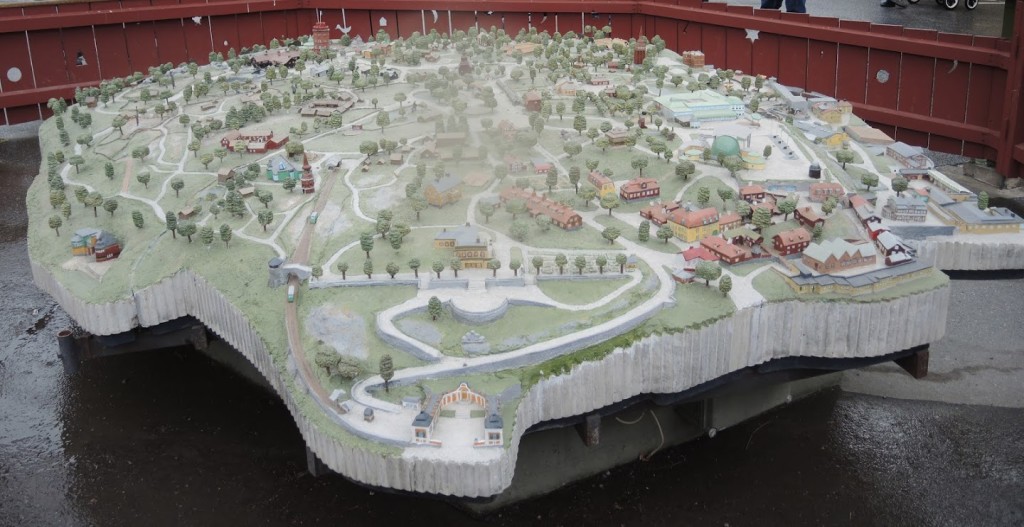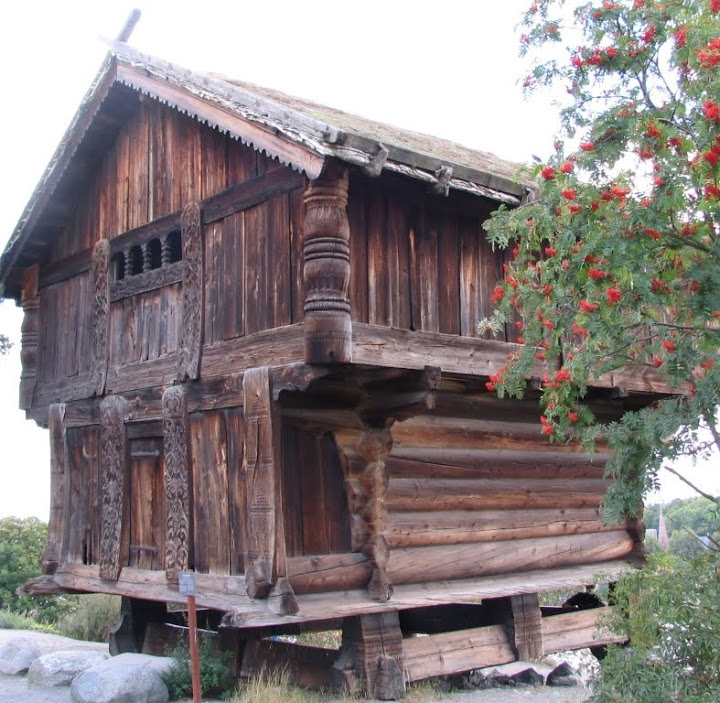(Disclaimer: Yes, I know the correct pronunciation is SKAHN-sn but you probably didn’t know that and you do know that I’m compulsive.)
After my visit to the Vasa Museum, I took another peek at the queue outside the Abba Museum and, thinking it still too long, again decided to pass on the siren song of that museum and take in another of Djurgarden’s attractions. Feeling that I’d spent enough time indoors, I decided to visit Skansen.
Founded in 1891 by Artur Hazelius, Skansen is, depending on one’s definition, one of the world’s two oldest open-air museums. While some random historic sites and buildings were opened to the public earlier in the 19th century, the idea of a planned assembly of open-air museums was a creation of late 19th century Scandinavia.
The world’s first open-air museum was King Oscar II’s collection near Oslo in Norway, opened in 1881. The original design plans intended to incorporate a dozen or so buildings that would trace the evolution of traditional Norwegian building types dating from the Middle Ages. The project proved more expensive than the king anticipated and he transported only five buildings – the stave church and four historic fame buildings from the town of Gol – to the royal manor at Bygdøy. The royal open-air museum was later incorporated into the Norsk Folkemuseum, established on an adjacent property in the 1890s . Thus, one could argue (as Skansen does) that Skansen is, in fact, the oldest open-air museum in the world (as long as you add the caveat that no other older such museum exists independently from any other museum).
Of course, as I was paying for my ticket, the rain that had been contained in the threatening gray skies of the morning and early afternoon began to overflow its cloudy confines and it would continue to do so nearly incessantly and at varying levels of intensity for most of the remainder of the afternoon. Fortunately, a nearby kiosk had umbrellas for sale. This proved to be the best 75 kronor (of any national currency) I spent on the trip.
(I will mention as an aside here that Scandinavian weather forecasters make predictions with perhaps less accuracy than the meteorologists I’ve become accustomed to doubting in the D.C. area. All too often, the opposite of the predicted weather came to pass. For example, in writing about my day in Copenhagen, I neglected to mention that the weather forecast predicted a 100 percent chance of rain between 15:00 and 17:00. I borrowed an umbrella from the hotel and carried it all about the city without ever encountering the need to open it. I needed to borrow the umbrella because I pack as little as possible, so I rarely pack an umbrella. I’d just as soon buy a cheap $8 or $10 umbrella or an even cheaper poncho and give either away before I leave for home.)
Before I delve into some of the details about Skansen, I feel compelled to provide at least a few words about its founder, Artur Hazelius. The last picture in the Skansen photo album is of the Nordic Museum which Hazelius also founded. He was a teacher and folklorist who, as he traveled about Sweden, grew concerned about what he perceived as the erosive influence of immigration and industrialization on traditional Scandinavian folk culture and architecture. In 1873 he established the Scandinavian ethnographic collection which, in 1880, became the Nordic Museum. Still not satisfied, he established Skansen as an open-air museum in 1891 and it became the model for all such museums that followed. Hazelius died in 1901 and is buried in Skansen. 
The above photo is of a scale model of the 75-acre Skansen complex. Needless to say, I didn’t see it all. The entrance at the bottom of the model is called the Hazelius entrance and, if you look closely, you might be able to discern a funicular railway just to the left of that entrance.
In his initial vision, Hazelius sought to preserve elements of Swedish rural life and he did so by transporting a complete farm from both the Skåne region in the south and from a Sami camp in the north. Unlike a traditional museum, Skansen doesn’t simply contain artifacts but rather entire buildings and farmsteads. Even with this, Hazelius wasn’t satisfied. Skansen also has cultivated plots and gardens and both domestic and wild animals. In fact, some 75 different species and breeds of Scandinavian animals are represented there. If you want, you can see traditional breeds of cows, pigs, horses, sheep and goats, geese, hens, ducks, and reindeer. There’s also a zoo populated with wild animals including brown bears, wolves, seals, lynx, wolverines, and elk.
Skansen is very much a living museum. In the years since Hazelius established it, some 150 houses and farmsteads have been moved to the property. Those include an 18th century wooden church, a village hall, a manor house, and a cottage for indentured farm laborers. There’s also a town quarter that consists principally of buildings from Stockholm that illustrate urban life in Sweden in the 18th and 19th centuries. Most of these buildings were moved to Skansen during the 1920s and 1930s and they include both dwellings and workshops. Among the exemplary buildings, you can see an engraver’s workshop, a shoemaker’s shop, and a traditional bakery.
In part because of its size, Skansen is always growing and changing. In the early 1990s the museum added a small industrial area with factories from the early 20th century. Interestingly, perhaps the oldest building in Skansen  is the Vastveit Storehouse which dates from 14th century Norway. However, it’s not out of place when you recall that Norway had a union with Sweden until 1905. However, the building is unique in being the only non-Swedish building at Skansen. The newest additions – two allotment huts from Stockholm – with one representing the 1920s and the other the 1940s – came to Skansen in 1997.
is the Vastveit Storehouse which dates from 14th century Norway. However, it’s not out of place when you recall that Norway had a union with Sweden until 1905. However, the building is unique in being the only non-Swedish building at Skansen. The newest additions – two allotment huts from Stockholm – with one representing the 1920s and the other the 1940s – came to Skansen in 1997.
In the next post, I’ll visit an area of Skansen of particular personal interest.
Note: In keeping with my 2022-2023 reformation of the blog into shorter entries, backdated to maintain their sequence, any comments on this post might pertain to its new configuration. See the explanation in the post Conventions and Conversions.
Would love to hear more details about that dinner!!
In private conversation. Not for publication!